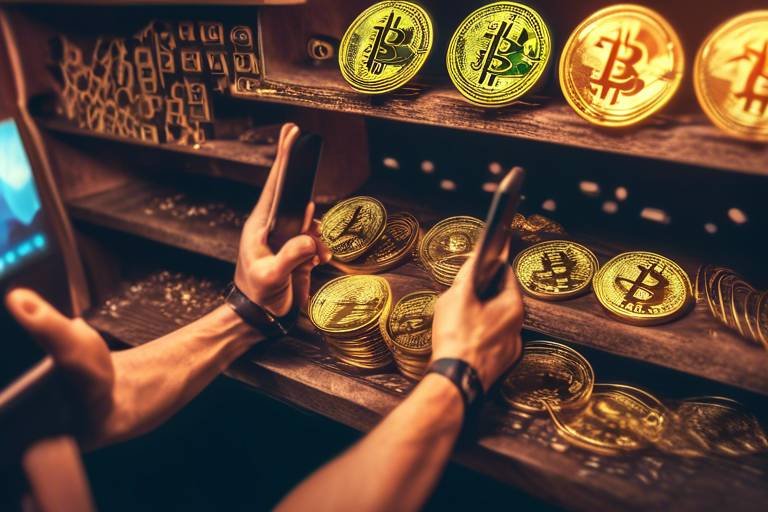The Impact of Interest Rates on Cryptocurrency Prices
In the ever-evolving world of finance, one cannot overlook the significant influence that interest rates wield over various asset classes, including cryptocurrencies. As we navigate through the complexities of today's financial landscape, it becomes evident that fluctuations in interest rates can have profound effects on the valuation of digital assets. But how exactly do these rates affect the prices of cryptocurrencies? This article aims to shed light on the intricate relationship between monetary policy and crypto markets, providing insights that every investor should consider.
Interest rates are essentially the cost of borrowing money, expressed as a percentage of the principal amount. They play a pivotal role in the economy, influencing borrowing, spending, and investment decisions. When central banks adjust interest rates, they are often responding to economic conditions—raising rates to curb inflation or lowering them to stimulate growth. This section will provide a deeper understanding of how interest rates are determined and their cascading effects on financial markets.
There’s a fascinating correlation between interest rates and cryptocurrency prices that investors need to grasp. Historically, when interest rates rise, traditional investments like bonds become more attractive, leading some investors to shift their capital away from riskier assets, including cryptocurrencies. Conversely, when rates are low, the appeal of high-risk, high-reward investments often increases, resulting in heightened interest in digital currencies. This section will explore these dynamics further, highlighting significant historical trends and market responses to changes in monetary policy.
To truly understand the impact of interest rates on cryptocurrencies, we must look back at historical trends. For instance, during periods of economic uncertainty, central banks often lower interest rates to encourage spending. This strategy can lead to a surge in cryptocurrency investments as people seek alternative avenues for wealth growth. Conversely, when rates are increased, we often see a pullback in crypto prices as investors reassess their risk tolerance. Analyzing past interest rate changes provides valuable insights into how various asset classes, including cryptocurrencies, have reacted under different economic conditions.
Let’s consider some specific case studies that illustrate the relationship between rate hikes and cryptocurrency markets. For example, during the Federal Reserve's rate hikes between 2017 and 2018, the cryptocurrency market experienced significant volatility. Prices for Bitcoin and other altcoins fluctuated wildly, showcasing how investor sentiment can shift dramatically in response to monetary policy changes. These case studies serve as a reminder of the inherent risks and opportunities present in the crypto space as interest rates change.
Understanding market sentiment is crucial in the cryptocurrency realm, especially in relation to interest rates. When interest rates rise, the mood among investors can shift from bullish to bearish almost overnight. This psychological factor plays a significant role in decision-making processes. Investors may perceive rising rates as a signal to pull back from high-risk investments, leading to a decrease in crypto prices. Conversely, when rates are low, the optimism in the market often flourishes, encouraging more investments in cryptocurrencies.
As we look at the current economic climate, it’s essential to consider how interest rates and inflation are influencing cryptocurrency investments today. With central banks around the world grappling with inflationary pressures, the decisions they make regarding interest rates can have immediate implications for the crypto market. Investors must remain vigilant, adapting their strategies to navigate these changing conditions effectively.
As interest rates fluctuate, savvy investors recognize the need to adapt their strategies accordingly. This section will delve into how cryptocurrency investors can modify their approaches in response to shifting economic conditions, ensuring they remain competitive in the market.
Diversification is a key strategy for managing risk, especially in a volatile market like cryptocurrencies. By spreading investments across various asset classes, including stocks, bonds, and digital currencies, investors can effectively balance their portfolios amid shifting interest rates. This approach not only mitigates risk but also positions investors to capitalize on different market conditions.
The impact of interest rates can vary significantly for long-term and short-term investors. For long-term holders, rising rates may present an opportunity to buy at lower prices, while short-term traders might need to react quickly to market shifts. Understanding these differing strategies is essential for anyone looking to navigate the complexities of cryptocurrency investments in a changing economic landscape.
- How do interest rates affect cryptocurrency prices? Interest rates can influence investor behavior, leading to shifts in demand for cryptocurrencies based on perceived risk and reward.
- What should investors consider during rate hikes? Investors should assess their risk tolerance and consider diversifying their portfolios to mitigate potential losses during periods of rising interest rates.
- Are cryptocurrencies a good investment during low interest rates? Low interest rates often encourage investment in riskier assets, including cryptocurrencies, as traditional savings yield lower returns.

Understanding Interest Rates
Interest rates are fundamental economic indicators that play a pivotal role in shaping the financial landscape. They represent the cost of borrowing money or the return on savings and investments, essentially acting as the price of money. When you hear someone mention interest rates, think of them as the heartbeat of the economy; they can pump life into growth or constrict it, depending on their direction. But how are these rates determined? Well, several factors come into play, including inflation rates, central bank policies, and the overall economic environment.
At the core, interest rates are influenced by the monetary policy set by central banks, like the Federal Reserve in the United States. When a central bank decides to increase interest rates, it typically aims to curb inflation and stabilize the economy. Conversely, lowering interest rates is often a strategy to stimulate economic growth by encouraging borrowing and spending. This delicate balancing act can create ripples across various asset classes, including cryptocurrencies.
To illustrate how interest rates work, let’s break it down a bit further. Here are some key components:
- Nominal Interest Rates: This is the stated interest rate before adjustments for inflation. It’s what you see advertised by banks.
- Real Interest Rates: This figure accounts for inflation, providing a more accurate picture of the purchasing power of your money. It’s calculated by subtracting the inflation rate from the nominal rate.
- Central Bank Rates: These are the rates at which banks lend to each other overnight. Changes here can influence the broader market rates.
The relationship between interest rates and economic activity is complex but crucial. For instance, when interest rates are low, borrowing becomes cheaper, leading to increased spending by consumers and businesses. This can fuel economic growth and, in many cases, drive up the prices of assets like stocks and cryptocurrencies. On the flip side, when rates rise, borrowing costs increase, often leading to reduced spending and investment. This can create a ripple effect, causing asset prices to fall as investors pull back.
In summary, understanding interest rates is essential for anyone looking to navigate the financial markets, especially in the realm of cryptocurrencies. They don't operate in a vacuum; rather, they are intricately linked to broader economic trends and investor sentiment. As we delve deeper into the relationship between interest rates and cryptocurrency prices, it becomes clear that these fluctuations can significantly impact digital asset valuation, making it vital for investors to stay informed and adaptable.

The Link Between Interest Rates and Crypto
When we talk about the relationship between interest rates and cryptocurrency prices, it’s almost like discussing the weather and its impact on our daily lives. Just as a sunny day can encourage us to go outside, low interest rates can stimulate investment in riskier assets like cryptocurrencies. On the flip side, when interest rates rise, it can be akin to a sudden rainstorm that makes us reconsider our plans. This section dives deep into the intricate dance between monetary policy and the ever-fluctuating crypto market.
Historically, interest rates have served as a crucial indicator of economic health, influencing everything from consumer spending to corporate investments. When central banks adjust these rates, they send ripples through the financial markets. For instance, a decrease in interest rates typically makes borrowing cheaper, which can lead to increased spending and investment. This influx of capital often finds its way into the cryptocurrency market, driving prices up. Conversely, when rates rise, the cost of borrowing increases, leading to a tightening of liquidity in the market. Investors may pull back, opting for safer assets, which can result in a decline in crypto prices.
To understand this relationship better, let’s take a look at some historical trends. During periods of low interest rates, such as in the aftermath of the 2008 financial crisis, we saw a significant surge in Bitcoin prices. Investors, seeking higher returns, flocked to cryptocurrencies as traditional investments like stocks and bonds offered lower yields. In contrast, when the Federal Reserve began raising interest rates in 2015, there was a marked slowdown in crypto price growth, as investors shifted their focus back to more traditional assets.
Consider the events surrounding the Federal Reserve's interest rate hikes in 2018. As the Fed implemented a series of increases, the cryptocurrency market experienced notable volatility. Bitcoin, which had reached an all-time high in December 2017, saw its price plummet over the following months. This decline can be attributed to a combination of factors, including investor sentiment shifting towards traditional assets as borrowing costs increased. The psychological impact of rising rates cannot be underestimated; it often leads to a sense of caution among investors, who may fear that the high returns seen in the crypto market are unsustainable.
Another key factor to consider is market sentiment. The crypto market is notoriously driven by emotions, and interest rate changes can significantly impact investor psychology. For example, when rates are low, there’s a sense of optimism and risk-taking among investors, which can lead to speculative bubbles. However, as rates rise, fear and uncertainty often take hold, causing investors to reassess their positions. This shift in sentiment can lead to sharp sell-offs in the crypto market, as seen during various rate hike cycles.
Understanding the psychological factors at play in the crypto space is crucial for investors. When interest rates change, it’s not just the numbers that matter; it’s how those numbers are perceived. Investors often react to interest rate announcements with immediate buying or selling, influenced by their expectations of future market conditions. This can create a feedback loop where initial reactions amplify price movements, leading to increased volatility.
In conclusion, the link between interest rates and cryptocurrency prices is a complex interplay of economic indicators and investor behavior. By keeping an eye on interest rate trends, investors can better navigate the turbulent waters of the crypto market, making informed decisions based on both historical data and current sentiment. As we continue to witness fluctuations in monetary policy, understanding this relationship will be key to successful investing in digital assets.
- How do interest rate changes affect cryptocurrency investments?
Interest rate changes can influence investor behavior, leading to increased or decreased demand for cryptocurrencies based on the perceived risk and return. - What historical events have impacted crypto prices due to interest rate changes?
Significant rate hikes by central banks, such as the Federal Reserve, have historically led to declines in cryptocurrency prices as investors shift to safer assets. - Should I invest in cryptocurrencies during low interest rates?
Low interest rates can create a favorable environment for investing in cryptocurrencies, as they often lead to increased risk appetite among investors.

Historical Trends of Interest Rates
When we dive into the world of economic indicators, interest rates stand out as one of the most influential factors shaping financial landscapes. Over the decades, interest rates have experienced significant fluctuations, often dictated by the economic climate, inflationary pressures, and central bank policies. Understanding these trends is crucial, especially when we consider their impact on various asset classes, including cryptocurrencies. For instance, during the late 1970s and early 1980s, the United States faced soaring inflation, prompting the Federal Reserve to raise interest rates to unprecedented levels, reaching over 20%. This aggressive monetary policy was aimed at curbing inflation but had ripple effects across all markets.
Fast forward to the 2008 financial crisis, where interest rates were slashed to near-zero levels to stimulate economic recovery. This period saw a remarkable shift in investment strategies, with many investors turning to alternative assets like cryptocurrencies. The zero interest rate policy created an environment ripe for speculative investments, leading to the meteoric rise of Bitcoin and other digital assets. The historical context is essential to grasp how such economic policies can influence investor behavior and market dynamics.
To illustrate these trends more clearly, let's take a look at a table summarizing key historical interest rate changes and their corresponding effects on the broader market:
| Year | Interest Rate (%) | Market Reaction |
|---|---|---|
| 1980 | 20.0 | Market contraction; rise in gold and commodities |
| 2008 | 0.25 | Surge in alternative investments; rise of Bitcoin |
| 2015 | 0.50 | Gradual recovery; cautious optimism in equities |
| 2020 | 0.25 | Crypto boom; increased retail investor participation |
As we analyze these historical trends, it becomes evident that interest rates not only influence traditional markets but also create a domino effect on newer asset classes like cryptocurrencies. Investors often react to the economic climate, adjusting their portfolios in response to rate changes. For example, when rates are low, borrowing becomes cheaper, leading to increased spending and investment in riskier assets. Conversely, when rates rise, the cost of borrowing increases, which can dampen market enthusiasm and lead to a sell-off in speculative assets.
Moreover, the psychological aspect cannot be ignored. Investors tend to be influenced by prevailing narratives and sentiments surrounding interest rates. When rates are expected to rise, fear of a market correction can lead to panic selling, while low rates can create a sense of euphoria, encouraging more speculative behavior. This interplay between interest rates and market sentiment is a fascinating aspect of financial psychology that warrants further exploration.
In summary, the historical trends of interest rates serve as a crucial backdrop for understanding the current dynamics of the cryptocurrency market. As we continue to witness fluctuations in interest rates, it’s essential for investors to keep an eye on these trends and their potential implications for their investment strategies.

Case Studies: Rate Hikes and Crypto Markets
When it comes to understanding the impact of interest rate hikes on cryptocurrency markets, examining specific case studies can provide invaluable insights. One of the most notable instances occurred in December 2015 when the Federal Reserve raised interest rates for the first time in nearly a decade. This pivotal moment sent ripples through various asset classes, including cryptocurrencies. While Bitcoin was still in its nascent stage, the market reacted with a blend of optimism and skepticism. Investors were unsure how the tightening monetary policy would affect their digital assets, leading to increased volatility.
Fast forward to 2018, when the Federal Reserve embarked on a series of rate hikes. During this period, Bitcoin reached its all-time high of nearly $20,000 in December 2017. However, as interest rates continued to climb throughout 2018, market sentiment shifted dramatically. The cryptocurrency market experienced a significant downturn, with Bitcoin losing more than 80% of its value by the end of 2018. This case underscores the sensitive nature of cryptocurrencies to macroeconomic factors, particularly interest rates. Investors began to perceive digital assets as riskier, reallocating their portfolios in favor of more stable investments.
Another intriguing case is the rate hike cycle initiated in 2022. As inflation surged, the Federal Reserve responded with aggressive interest rate increases. The cryptocurrency market, which had seen a meteoric rise during the pandemic, faced a stark reality check. The price of Bitcoin and other major cryptocurrencies plummeted, as investors reacted to the tightening liquidity. The correlation between rising rates and falling crypto prices became evident, with many attributing the downturn to the increased cost of borrowing and the shift in investor sentiment towards traditional assets.
To further illustrate these dynamics, let's take a look at a comparative table of rate hikes and Bitcoin price movements during key periods:
| Year | Federal Reserve Rate Change | Bitcoin Price Change |
|---|---|---|
| 2015 | First Rate Hike (+0.25%) | Increased volatility, price fluctuation |
| 2018 | Multiple Rate Hikes (+0.25% each) | Price dropped from $20,000 to ~$3,000 |
| 2022 | Aggressive Rate Hikes (+0.75% each) | Price fell from $69,000 to ~$20,000 |
These case studies highlight a critical relationship between interest rates and cryptocurrency markets. As rates rise, the cost of capital increases, leading to a shift in investor behavior. Individuals and institutions may pivot towards safer, more traditional investments, causing cryptocurrencies to experience price declines. Additionally, the psychological aspect of market sentiment plays a crucial role; when interest rates go up, fear and uncertainty can drive investors away from the perceived volatility of digital assets.
In conclusion, the historical context of rate hikes provides a compelling narrative about the fragility and resilience of cryptocurrency markets. Understanding these dynamics can help investors navigate the choppy waters of the crypto landscape, especially during times of economic uncertainty.
- How do interest rates affect cryptocurrency prices? Interest rates influence borrowing costs and investor sentiment, which can lead to increased volatility in cryptocurrency markets.
- What historical events have impacted crypto prices due to rate changes? Significant rate hikes in 2015, 2018, and 2022 have all led to notable shifts in cryptocurrency prices.
- Should I invest in cryptocurrency during rising interest rates? While some investors may choose to diversify during rate hikes, it ultimately depends on individual risk tolerance and investment strategy.

Market Sentiment and Interest Rates
When it comes to the world of cryptocurrency, one thing is crystal clear: market sentiment plays a pivotal role in shaping prices. But how does this market sentiment intertwine with interest rates? Well, it's a bit like a dance—one step influences the other, creating a rhythm that can either lead to a smooth waltz or a chaotic tango. As interest rates fluctuate, they send ripples through the financial markets, affecting how investors feel about their assets, including cryptocurrencies.
In a low-interest-rate environment, borrowing becomes cheaper, and investors often feel more optimistic. This optimism can lead to increased investment in riskier assets like cryptocurrencies. Why? Because when traditional savings accounts or bonds yield little to no interest, the allure of high-risk, high-reward assets becomes irresistible. Conversely, when interest rates rise, the cost of borrowing increases, and suddenly, the risk associated with cryptocurrencies might not seem worth it. Investors may retreat to safer havens, causing a dip in crypto prices.
Moreover, it’s essential to recognize the psychological factors at play. When interest rates are low, the sentiment is often buoyed by a sense of economic stability and growth. Investors might feel emboldened to enter the crypto market, believing that the overall economy is on an upward trajectory. In contrast, rising interest rates can induce fear and uncertainty, leading to a more cautious approach. This shift in sentiment can be observed through various indicators, such as trading volumes and social media discussions, which often reflect the general mood of the market.
To illustrate the impact of interest rates on market sentiment, let’s consider a few key points:
- Interest Rate Announcements: When central banks announce changes to interest rates, it often results in immediate reactions in the crypto market. For instance, a surprise rate hike can lead to panic selling.
- Investor Behavior: Investors may adjust their portfolios based on expected interest rate changes, moving funds out of cryptocurrencies into more stable investments.
- Market Volatility: Increased interest rates can heighten market volatility as investors react to both economic news and the performance of digital assets.
Understanding this dynamic is crucial for anyone looking to navigate the murky waters of cryptocurrency investing. By keeping an eye on interest rates and their potential impact on market sentiment, investors can make more informed decisions, positioning themselves to either capitalize on opportunities or safeguard their investments during turbulent times.
- How do interest rates affect cryptocurrency prices? Interest rates can influence borrowing costs and investor sentiment, which in turn affects demand for cryptocurrencies.
- What should investors do when interest rates rise? Investors might consider diversifying their portfolios and reassessing their risk tolerance, as higher rates can lead to decreased interest in riskier assets.
- Are cryptocurrencies a good investment during low-interest periods? Low-interest rates often encourage investment in higher-risk assets, making cryptocurrencies more appealing.

Current Economic Climate
The current economic climate is a swirling vortex of uncertainty, influenced by a myriad of factors including interest rates, inflation, and global events. As central banks around the world adjust their monetary policies to combat inflation, the ripple effects are felt across all asset classes, including the ever-volatile world of cryptocurrency. Investors are left wondering how these shifts will impact their digital assets, and rightly so.
Interest rates are currently at a pivotal point, with many economies experiencing rate hikes as policymakers attempt to rein in inflation. For instance, in the United States, the Federal Reserve has been gradually increasing rates in response to rising consumer prices, which have surged due to supply chain disruptions and increased demand post-pandemic. This environment leads to higher borrowing costs, affecting consumer spending and investment. As a result, the crypto market is not immune to these changes; fluctuations in interest rates can lead to significant price volatility in digital currencies.
Moreover, inflation continues to be a pressing concern. As the cost of living rises, consumers and investors alike are seeking ways to preserve their purchasing power. Cryptocurrencies, often viewed as a hedge against inflation, attract attention in this context. However, the relationship between inflation and crypto is complex. While some investors flock to digital currencies as a safe haven, others may pull back due to the increased risk associated with higher interest rates. This tug-of-war creates a dynamic market where prices can swing dramatically in response to economic news.
To better understand the current economic landscape, let’s take a look at some key indicators:
| Indicator | Current Status | Implications for Crypto |
|---|---|---|
| Interest Rates | Increasing | Potential downward pressure on crypto prices |
| Inflation Rate | High | Increased interest in crypto as an inflation hedge |
| Consumer Spending | Moderate | Impact on demand for non-essential assets like crypto |
As we navigate this uncertain terrain, it’s essential for investors to remain informed and adaptable. The current economic climate is not just a backdrop; it’s a living, breathing entity that shapes the decisions made in the crypto market. Understanding the interplay between interest rates and cryptocurrency prices is crucial for anyone looking to invest in this space. The effects of these economic indicators are profound, influencing not just market sentiment but also the strategic decisions of investors across the globe.
In summary, the current economic climate presents both challenges and opportunities for cryptocurrency investors. With interest rates on the rise and inflation continuing to loom large, the landscape is shifting. Investors must stay vigilant, adapting their strategies to not only survive but thrive in this ever-changing environment.
- How do interest rate hikes affect cryptocurrency prices?
Interest rate hikes often lead to higher borrowing costs, which can decrease investor appetite for riskier assets like cryptocurrencies, potentially driving prices down. - Can cryptocurrencies act as a hedge against inflation?
Many investors view cryptocurrencies as a store of value that can protect against inflation, although this relationship can vary based on market conditions. - What should investors consider in a fluctuating interest rate environment?
Investors should consider diversifying their portfolios, understanding their risk tolerance, and staying informed about economic indicators that influence market dynamics.

Investor Strategies in a Changing Rate Environment
As interest rates fluctuate, investors find themselves navigating a complex landscape that demands flexibility and adaptability. The relationship between interest rates and cryptocurrency prices is both intricate and dynamic, which means investors must be prepared to modify their strategies to align with ongoing economic shifts. Just like a seasoned sailor adjusts their sails to catch the changing winds, crypto investors need to be agile in their approach to capitalize on opportunities while mitigating risks.
One effective strategy is diversification. By spreading investments across various asset classes, including cryptocurrencies, stocks, and bonds, investors can reduce the impact of volatility in any single market. This becomes particularly important in a climate of rising interest rates, where traditional investments might yield better returns compared to digital assets. For instance, if interest rates increase, traditional savings accounts or bonds may become more attractive, potentially drawing investment away from cryptocurrencies. Therefore, a well-diversified portfolio allows investors to balance their exposure and hedge against potential downturns in the crypto market.
Another consideration is the distinction between long-term and short-term investing. Short-term investors, often driven by market trends and quick gains, may react more sensitively to interest rate changes. For them, the environment can be tumultuous; rising rates might lead to increased volatility in crypto prices, prompting swift buying or selling decisions. On the other hand, long-term investors might view interest rate hikes as a natural part of economic cycles, focusing instead on the overall growth potential of their digital assets over time. They might hold onto their investments, believing that despite short-term fluctuations, the long-term outlook for cryptocurrencies remains positive.
Furthermore, understanding market sentiment is crucial. Investors need to keep a pulse on how the broader financial market reacts to interest rate changes. For example, when central banks announce rate hikes, it can lead to a wave of fear and uncertainty that affects investor behavior. This psychological aspect can create buying opportunities for those who are willing to go against the grain and invest when others are hesitant. The key is to stay informed and be aware of the emotional triggers that can sway market dynamics.
In summary, navigating the shifting tides of interest rates requires a multifaceted approach. By diversifying their portfolios, distinguishing between investment horizons, and being attuned to market sentiment, investors can better position themselves to thrive in a changing economic environment. It’s all about being proactive rather than reactive, ensuring that when the winds change, they’re ready to sail smoothly through the waves of the crypto market.
- How do interest rates affect cryptocurrency prices? Interest rates influence the cost of borrowing and the attractiveness of various investments. When rates rise, traditional investments may offer better returns, leading to potential declines in crypto prices.
- What is the best strategy for investing in cryptocurrencies during rate hikes? Diversification and a clear understanding of your investment horizon are key. Long-term investors may hold onto their assets, while short-term investors might need to be more agile.
- Can market sentiment impact cryptocurrency investments? Absolutely! Market sentiment can drive price volatility, especially during times of economic uncertainty, making it essential for investors to stay informed and responsive.

Diversification in Investment Portfolios
Diversification is like a safety net for your investments, especially in the unpredictable world of cryptocurrency. Imagine you're at a carnival, and you decide to try out different rides instead of sticking to just one. Why? Because if one ride breaks down, you still have others to enjoy! Similarly, when you spread your investments across various assets, you reduce the risk of a total loss. In the context of cryptocurrencies, this means not putting all your eggs in one digital basket. By diversifying, you can potentially enhance your returns while minimizing the impact of volatility that often plagues the crypto market.
So, how do you achieve this diversification in your crypto portfolio? First, consider investing in a mix of established cryptocurrencies like Bitcoin and Ethereum, alongside some promising altcoins. Each of these digital assets reacts differently to market changes. For instance, while Bitcoin is often viewed as a "digital gold," altcoins may offer higher growth potential but come with increased risk. It's essential to strike a balance that aligns with your risk tolerance and investment goals.
Moreover, diversification isn't solely about the number of cryptocurrencies you hold; it's also about the types of assets. For example, you might want to include not just cryptocurrencies, but also stablecoins, which can provide stability during turbulent market conditions. By having a portion of your portfolio in stablecoins, you can effectively shield yourself from the dramatic price swings that are characteristic of the crypto market. This strategy allows you to maintain liquidity while waiting for more favorable market conditions to re-enter more volatile assets.
To illustrate the benefits of diversification, let’s take a look at a simple table comparing two hypothetical portfolios over a year:
| Portfolio Type | Assets | Year-End Value | Volatility |
|---|---|---|---|
| Concentrated Portfolio | 100% Bitcoin | $50,000 | High |
| Diversified Portfolio | 40% Bitcoin, 30% Ethereum, 20% Stablecoins, 10% Altcoins | $55,000 | Low |
As shown in the table, while the concentrated portfolio experienced high volatility, the diversified portfolio not only yielded a better year-end value but also exhibited lower volatility. This example underscores the importance of having a well-rounded investment strategy.
In conclusion, diversification in investment portfolios is a critical strategy for anyone looking to navigate the choppy waters of cryptocurrency investments. By carefully selecting a mix of assets, including a blend of established coins and stablecoins, investors can create a more resilient portfolio. Remember, it’s not just about what you invest in, but how you spread your investments that can make all the difference in achieving your financial goals.
- What is diversification in investing? Diversification is the practice of spreading investments across various assets to reduce risk.
- Why is diversification important for cryptocurrency investments? It helps mitigate risks associated with the volatility of the crypto market and can enhance potential returns.
- How can I diversify my crypto portfolio? By investing in a mix of established cryptocurrencies, altcoins, and stablecoins, you can create a balanced portfolio.
- Is there a recommended percentage for each asset type in a diversified portfolio? It depends on your risk tolerance, but a common approach is to allocate more to established coins and less to riskier altcoins.

Long-term vs. Short-term Investing
When it comes to investing in cryptocurrencies, the debate between long-term and short-term strategies is as heated as a summer day in the desert. Each approach has its own set of advantages and disadvantages, and understanding these can help investors navigate the often tumultuous waters of the crypto market. So, what’s the real difference between these two strategies, and how do interest rates play into the equation?
Long-term investing is like planting a tree. You nurture it, water it, and patiently wait for it to grow, often over several years. Investors who adopt this strategy believe in the fundamental value of cryptocurrencies and are less concerned with daily price fluctuations. They tend to focus on the potential of blockchain technology and the overall growth of the digital asset market. This approach can be particularly appealing in a low-interest-rate environment, where traditional savings accounts yield minimal returns. Instead of letting their money sit idle, long-term investors might prefer to allocate funds to cryptocurrencies, anticipating significant appreciation over time.
On the flip side, short-term investing is akin to a roller coaster ride—thrilling, fast-paced, and sometimes scary. This strategy involves buying and selling cryptocurrencies over shorter time frames, often capitalizing on market volatility. Short-term investors, or traders, are more sensitive to interest rate changes since these fluctuations can spark sudden market reactions. For instance, if interest rates rise, the cost of borrowing increases, which could lead to a decrease in disposable income and, consequently, a drop in crypto investments. This is where understanding market sentiment becomes crucial. Traders need to be agile, adjusting their strategies based on real-time data and economic indicators.
To illustrate the differences between long-term and short-term investing in cryptocurrency, let’s consider a few key aspects:
| Aspect | Long-term Investing | Short-term Investing |
|---|---|---|
| Investment Horizon | Years | Days to Months |
| Risk Tolerance | Lower (focus on fundamentals) | Higher (focus on market trends) |
| Market Strategy | Buy and Hold | Active Trading |
| Response to Interest Rates | Less sensitive | Highly sensitive |
Ultimately, the choice between long-term and short-term investing in cryptocurrencies should align with your personal financial goals, risk tolerance, and market outlook. Some investors even choose to blend both strategies, creating a diversified approach that allows them to take advantage of short-term opportunities while still holding onto long-term positions. This hybrid strategy can provide a balance, especially in a fluctuating interest rate environment.
In conclusion, whether you're a long-term visionary or a short-term trader, understanding how interest rates influence your investment strategy is vital. The crypto market is unpredictable, but with the right knowledge and approach, you can navigate it successfully.
- What is the primary difference between long-term and short-term investing in cryptocurrency? Long-term investing focuses on holding assets for years, while short-term investing involves quick trades based on market movements.
- How do interest rates affect cryptocurrency prices? Changes in interest rates can influence investor behavior, affecting demand for cryptocurrencies and leading to price fluctuations.
- Can I combine both investing strategies? Yes, many investors adopt a hybrid approach, utilizing both long-term and short-term strategies to balance risk and opportunity.
Frequently Asked Questions
- How do interest rates affect cryptocurrency prices?
Interest rates play a significant role in shaping the financial landscape, impacting everything from borrowing costs to investment decisions. When interest rates rise, traditional investments like bonds become more attractive, which can lead to a decrease in demand for cryptocurrencies. Conversely, lower interest rates can encourage more investment in riskier assets like digital currencies, potentially driving up their prices.
- What is the historical relationship between interest rates and crypto?
Historically, there have been notable correlations between interest rate changes and cryptocurrency price movements. For instance, during periods of aggressive rate hikes, many cryptocurrencies experienced significant volatility. Analyzing these trends helps investors understand how past events shaped market behavior, allowing for more informed decisions in the future.
- How should investors adapt their strategies based on interest rate changes?
Investors need to stay agile in a changing rate environment. Strategies such as diversifying portfolios can help manage risk effectively. By balancing investments across various asset classes, including both cryptocurrencies and traditional assets, investors can navigate the uncertainties that come with fluctuating interest rates.
- What are the psychological factors influencing crypto investors during rate changes?
Market sentiment is heavily influenced by interest rate changes. When rates rise, fear and uncertainty can set in, causing investors to rethink their positions. Understanding these psychological factors is crucial for making sound investment decisions, as emotions often drive market reactions more than fundamentals.
- Is it better to invest in crypto for the long-term or short-term during fluctuating interest rates?
The impact of interest rates varies significantly between long-term and short-term investors. Long-term investors might focus on the overall trend and potential of cryptocurrencies, while short-term traders may react more quickly to rate changes, seeking immediate profit opportunities. Each approach has its benefits and risks, so understanding personal investment goals is essential.



















